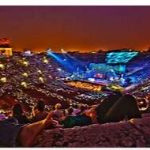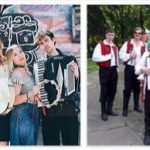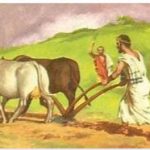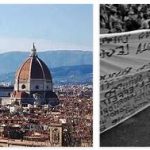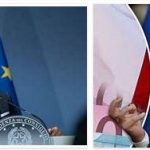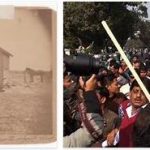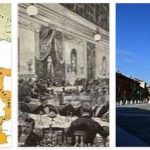The spread of postweberian serialism which occurred in the 1950s also marked in Italy, as in the rest of Europe, the beginning of a radical renewal in the whole of musical life. The first Italian presences in Darmstadt were in fact those of young composers of great importance, among which we must remember first of all L. Nono (1924-1990), who was immediately among the major representatives of the European neo-avant-garde with the German K. Stockhausen and the French P Boulez, and again B. Maderna (1920-1973) and C. Togni (b. 1922).
Nono made his debut in 1951 in Darmstadt with Polifonica-Monodia-Ritmica, for chamber orchestra; later he moved away from serialism in favor of a musical discourse more sensitive to political commitment: works that date back to the early seventies, such as for example, belong to this new phase of his activity. Como una ola de fuerza y luz (1971-72), written in collaboration, among others, with the conductor C. Abbado (b. 1933) and the pianist M. Pollini (b. 1942). His later works include when they are dying (Polish Diary n. 2), for four female voices, flute, cello and synthesizer (1982); To Carlo Scarpa the architect, to his infinite possibilities, for orchestra ” a microintervalli ” (1984); Prometeo, ” listening tragedy ” (1982-83), based on a text by M. Cacciari, presented in Venice in September 1984.
Maderna made use of the serial technique in Serenata n. 2 for 11 instruments (1957). After experimenting with the electronic medium, he devoted himself to both instrumental and vocal experimental music (from Hyperion, on a text by Hölderlin, 1964, to Serenata for a satellite for 8 instruments, 1969). In later compositions he returned to electronic music (so in Tempo Libero I and Ausstrahlung for female voice, flute, oboe, orchestra and magnetic tape).
Among the most recent and significant works of Togni we will remember the three-scene drama Blaubart (1972-75), which was performed at the Fenice in Venice in December 1977.
If Maderna, Nono and Togni were in Darmstadt between 1949 and 1950, in the middle of the decade a second group of young Italian composers took part in the courses of the German city, who for their part further contributed to the diffusion of New Music in our country.: these are composers who by training and place of activity are usually partly traced back to the “ Milan area ”, as in the case of V. Fellegara (b.1927), N. Castiglioni (b.1932) and F. Donatoni (b. 1927), in part to the “Roman” one, such as A. Clementi (b. 1925), F. Evangelisti (1926-1980) and D. Guaccero (1927-1984).
Among the first works of Fellegara appears the ballet Mutazioni (1962), written with the collaboration of the poet N. Balestrini and the painter A. Perilli; among the following, the Notturno for soprano, alto, male choir and orchestra, based on a text by Verlaine (1971), and Chanson, for soprano and chamber orchestra, on verses by Eluard (1976) should be mentioned.
Castiglioni presented in 1958 in Darmstadt Beginning of movement for piano. Among his most significant works is Eine kleine Weihnachtsmusik for chamber orchestra (1959-60), presented at the Venice Film Festival in September 1960. Later, the two works in one act Oberon. The fairy Prince, and The Lord’s masque, performed in Venice in October 1981.
Donatoni first went back to J. Cage’s theories of indeterminacy (as in Quartetto IV ” Zrcadlo ”, from 1963), later inaugurating a new compositional phase with Puppenspiel 2, for flute and chamber orchestra (1966). More recently he has devoted himself to the theater with Atem, an opera performed at La Scala in February 1985. Among the most significant works by Clementi, the Concerto for violin, 40 instruments and carillons (1977) should be mentioned ; The Capriccio for viola and 24 instruments (1979-80); the rondo in one act Ex (1980), performed at the Fenice in Venice in April 1981. Among the other ” Romans ”, F. Evangelisti devoted himself particularly to electroacoustic experimentation, while D. Guaccero achieved remarkable results in Representation and exercise, a sacred action for 12 performers (1968), and in Descriptions of the body (1973-78).
Other young authors, who were also present in Darmstadt, nevertheless placed themselves at the forefront in the search for new forms open to the representative and theatrical element, thus breaking with a certain experimental purism still dominant in the early 1960s through serial structuralism. In this context it should be remembered A. Paccagnini (b. 1930), who in 1959 presented his work Le sue reasons (based on a text by E. Pagliarani), and above all G. Manzoni (b. 1932), who since at the beginning he showed himself sensitive to the political commitment opened in those years by Nono himself (who presented in 1960 the work Intolerance, based on a text by AM Ripellino), by Maderna and by Togni, proposing in 1960, also in Bergamo, L'(libretto by E. Jona, by F. Fortini), confirming himself in the following years as one of the most significant authors of the current Italian music scene. The composition of Ombre, for orchestra and choral voices, dates back to the 1960s, while in the following years he composed the Symphonic Scenes for Th. Mann’s Doktor Faustus (1984) and the Study for the finale of Doktor Faustus (1985). B. Porena (b.1927), E. Macchi (b.1928), G. Maselli (b.1929) and F. Razzi (b.1932) still belong to the ” Roman school ”.
According to IAMHIGHER, an autonomous formation with respect to the Darmstadtian one had another great representative of the neo-avant-garde, L. Berio (b. 1925).
After having adhered to the postwebernian modes in works such as Alleluja II for 5 instrumental groups (1957) and Sequenza I for solo flute (1958), Berio devoted himself to a radical experimentalism, which led him to the composition of remarkable works, up to La true story, based on a text by Italy Calvino (composed in 1976-79 and performed in Milan in 1982), and Un re in ascolto, again based on a text by Calvino (from 1982-83, performed in Salzburg in 1984).

